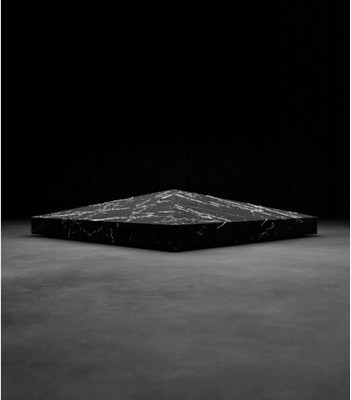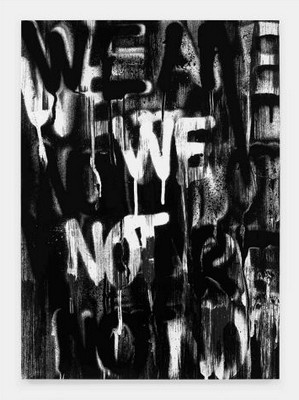David Adjaye / Adam Pendleton
Pace Gallery, Hong Kong
May 18 – June 30, 2021
Khufu, 2021
© David Adjaye, courtesy Pace Gallery
Untitled (WE ARE NOT), 2020
© Adam Pendleton, courtesy Pace Gallery
Pace Gallery presents the first ever two-person exhibition between internationally renowned American artist Adam Pendleton and Sir David Adjaye OBE, Ghanaian-British artist and world-leading architect. The exhibition features a new body of paintings entitled Untitled (WE ARE NOT), presented in visual and spatial dialogue with a set of sculptural works by David Adjaye. Viewed in concert, the works articulate a shared visual lexicon that explores questions of language, identity, and monumentality.
The two artists first met in 2016 while Pendleton was installing a solo exhibition at the Museum of Contemporary Art Denver, a building designed by David Adjaye. In the years that followed, their continued dialogue revealed a mutual interest in the politics of space and representation, as well as the relationship between art and architecture. The exhibition at Pace in Hong Kong will be the first time their independent endeavors have been presented in dialogue with one another.
Through a sustained and multifaceted engagement with painting, Adam Pendleton’s work explores the tensions between language, representation, and abstraction. The paintings enunciate three simple words, “we,” “are,” and “not,” which nevertheless form a complex matrix of meanings, constructing what Pendleton refers to as a series of “incomplete postulates.” He explains that the paintings, “like the voices of a multitude, do not accede to an identity. In their combinatorial repetition, they instead unfold a multiplicity: not-beings, not-nots, and being-nots.” Made up of multiple layers of spray paint, sharply defined brush marks, collage, and photographs, the Untitled (WE ARE NOT) paintings reveal a process of metamorphosis that refuses to speak itself into a final form, preferring to remain in a state of indeterminacy. As if capturing the process of predication, Adam Pendleton’s paintings generate open questions: Who or what is this we? Who or what is this not-we? What are we not? Are we whatnot? Who or what is not?
Originating from Adam Pendleton’s seminal Black Dada text of 2008, the phrase “WE ARE NOT” is broken down and merged to form all-over compositions. Adam Pendleton’s reiteration and reconfiguration of his own past language extends the dynamics of his ongoing Black Dada project, a conceptual framework through which the artist explores ideas about the future through the evocation of the past, with an emphasis on the relationship between blackness and the avant-garde. The Untitled (WE ARE NOT) paintings similarly address questions of historical and collective definition, alluding obliquely to the rhetoric of contemporary identity politics. Pendleton uses the repetition of such words to produce a kind of combinatorial patterning; what starts as “WE ARE NOT” quickly dissolves into “NOT NOT WE” and “NOT ARE WE.” These permutations, hovering on the edge of signification and meaninglessness, encode the often ambiguous, arbitrary, and fictitious logics at the heart of identity, which is often taken as self-evident.
David Adjaye’s modular geometric sculptures take the form of pyramids, yet are composed of individual elements with the capacity to be reconfigured in a variety of orientations. In this way, they echo the combinatorial possibilities of language explored in Adam Pendleton’s paintings. Working in marble—which is also among the most frequently used materials in the history of architecture—has enabled David Adjaye to distill broader ideas about materiality and form into objects that trouble the boundaries between art and architecture, while evoking the history of minimal sculpture.
In David Adjaye’s marble pyramids, there exists another kind of layering: the way in which their surfaces register the passage of geologic time. The material of marble is formed through the long history of geologic compression, in which minerals recrystallize to form streaks and veins. These marks on the body of the stone become a kind of writing, echoing the lexical logic of Adam Pendleton’s compositions in a radically different time scale. That David Adjaye’s sculptures appear static and immovable in their heavy solidity belies the fact that each of the four constituent parts can be reconfigured to produce multiple variations, giving them a sense of dynamism and play that is itself semantic in nature. In referring to the ancient form of the Egyptian pyramid—a form that encodes an entire cultural history of technological innovation and ancient African knowledge systems—these sculptures both extend and depart from David Adjaye’s broader architectural practice, in which he examines relationships formal and cultural meaning, between the canons of Classicism and the vernacular traditions of non-Western cultures.
This exhibition comes at an important juncture in both artists’ careers. This fall, Pendleton will present Who Is Queen?, a major solo exhibition at The Museum of Modern Art in New York. Meanwhile Pendleton recently unveiled his site-specific installation, As Heavy as Sculpture, in the lobby of the New Museum in New York, which was created for the landmark exhibition Grief and Grievance: Art and Mourning in America, originally conceived by the late Nigerian curator Okwui Enwezor.
Since the beginning of his career, David Adjaye’s architectural practice has been informed by his interest in contemporary art. Adjaye has collaborated with visual artists in the past, including Chris Ofili with whom he created The Upper Room, a room size installation permanently on view at Tate Britain as well as Kapwani Kiwanga, with whom he created Sankofa Pavilion, a glass structure used as a space for conversation, shown as part of Whitechapel Gallery’s Is This Tomorrow? exhibition in 2019. Alongside his numerous architectural projects, David Adjaye led the design of the Ghana Freedom Pavilion at the 58th Venice Biennale in 2019, the country’s first pavilion in the Artigliere of the historic Arsenale. Among his current projects are a new design for the Edo Museum of West African Art (EMOWAA) in Benin, Nigeria, the long-awaited new home for the Studio Museum in Harlem, and the Abrahamic Family House, an interfaith complex in Abu Dhabi.
ADAM PENDLETON (b. 1984, Richmond, Virginia), lives and works in New York. Adam Pendleton’s recent solo exhibitions include: Le Consortium, Dijon (2020); Isabella Stewart Gardner Museum, Boston (2020); MIT List Visual Arts Center, Cambridge, Massachusetts (2018); Baltimore Museum of Art (2017); KW Institute for Contemporary Art, Berlin (2017); Baltic Center for Contemporary Art, Gateshead, United Kingdom (2017); Museum of Contemporary Art Cleveland (2017); Museum of Contemporary Art Denver (2016); and Contemporary Arts Center, New Orleans (2016). Adam Pendleton’s work is included in the collections of the Museum of Modern Art, New York; Solomon R. Guggenheim Museum, New York; the Art Institute of Chicago; the Studio Museum in Harlem, New York; and Tate, London, among many other institutions.
Sir DAVID ADJAYE OBE is a Ghanaian-British architect who has received international acclaim for his impact on the field. In 2000, he founded Adjaye Associates, which today operates globally, with studios in Accra, London, and New York and projects spanning across the globe. David Adjaye’s largest project to date, The National Museum of African American History & Culture in Washington, DC opened on the National Mall in Washington DC in 2016 and was named Cultural Event of the Year by The New York Times. In 2017, David Adjaye was recognized as one of the 100 most influential people of the year by TIME Magazine. Most recently, David Adjaye was announced the winner of the 2021 RIBA Royal Gold Medal. Approved personally by Her Majesty the Queen, the Royal Gold Medal is considered one of the highest honors in British architecture for significant contribution to the field internationally. Sir David Adjaye is also the recipient of the World Economic Forum’s 27th Annual Crystal Award, which recognizes his “leadership in serving communities, cities and the environment.”
PACE GALLERY HONG KONG
12/F, H Queen’s, 80 Queen’s Road Central, Hong Kong


